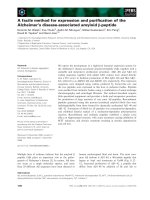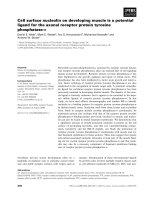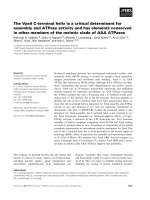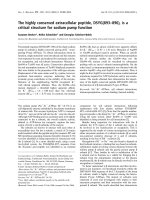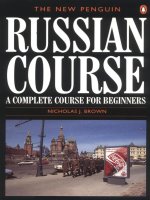Lets go workbook
Bạn đang xem bản rút gọn của tài liệu. Xem và tải ngay bản đầy đủ của tài liệu tại đây (414.02 KB, 35 trang )
z
Lets go workbook
DynEd
Let’s Go
Aligned to Arizona’s Standards
Listening and Speaking
General Description: Let’s Go is a multimedia course for beginning through
intermediate-level students of spoken English, ages 4-10. Created
by experienced teachers and based on classroom-proven
instructional strategies, Let’s Go maximizes the effectiveness of
multimedia by focusing on the key skill necessary to acquire
language: listening.
Proficiency Level: Beginning through intermediate
Course Description: Let’s Go is an eight unit series designed for beginning through
intermediate-level students of spoken English. Each unit opens
with a Song and a Conversation, followed by Vocabulary,
Grammar and Phonics lessons, and ends with a Game. Let’s Go
can be used on its own or in conjunction with the Let’s Go Student
Book, Picture Cards, and other supporting materials.
Computer-based Tools: Speech Recognition, Glossary, On-screen Text, Help, Translation
(for some languages)
Teacher Tools: Records Manager allows teachers to monitor individual and class
learning and suggests remediation.
Assessment: DynEd General Placement Test, Records Manager, Score-based
quizzes, computer-based prompting/feedback, Mastery Tests
Teacher Materials: Teacher’s Guide
DynEd
Course: Let’s Go
State: Arizona
Stadards: ELL Listening and Speaking
2
ELL I
Performance Conditions: Students at this stage comprehend simple statements and questions.
They understand the general idea of basic messages and conversations that pertain to common,
routine matters. Their interactions are short, face-to-face, informal, and with one person at a time
or in small groups. Although students can initiate and respond to basic statements, their speech is
largely guided by questions and feedback from the teacher. English learners rely heavily on
repetition, gestures, and other nonverbal cues to sustain conversations. Their speech is slow.
Communications that students listen to and comprehend are short and include familiar routine
words. Context strongly supports their utterances.
Delivery of Oral Communications
Standard: The student will express orally his or her own thinking and ideas.
Beginning Let’s Go
- Respond to greetings with simple words,
gestures, and other nonverbal behavior.
Level 1, Unit 1: Greetings,
Introducing yourself, Asking about
objects
All Units: Interaction with audio and
visual cues
- Use gestures to communicate basic
needs (e.g., points toward door when
needing to go to the restroom).
All Units: Interaction with visual cues
- Identify by name a few familiar objects,
people, and events (e.g., family
members, body parts, clothing, pets,
foods, common occupations, seasons,
common school, classroom, and home
objects).
Level 1, Unit 1: Names, Classroom
objects, Names, Classroom objects
Level 1, Unit 2: Describing objects,
Classroom objects
Level 1, Unit 3: Introducing friends,
Classroom objects
Early Intermediate
- Use common social greetings and simple
repetitive phrases using isolated words
or strings of 2- to 3-word responses (e.g.,
Hello. How are you? Thank you. You’re
welcome.)
Level 1, Unit 1: Greetings,
Introducing yourself
Level 1, Unit 3: Introducing friends
Level 1, Unit 4: Introducing family
members, meeting someone politely
- Use more utterances accompanied by
gestures to indicate basic needs (e.g.,
says “bathroom” while pointing toward
the door).
Level 1, Unit 7: Expressing hunger
and thirst, Asking what someone
wants, Expressing wants
- Identify by name some familiar objects,
people, and events (e.g., family
Level 1, Unit 1: Names, Classroom
objects
DynEd
Course: Let’s Go
State: Arizona
Stadards: ELL Listening and Speaking
3
members, body parts, clothing, pets,
foods, common occupations, seasons,
common school, classroom, and home
objects).
Level 1, Unit 2: Describing objects
Level 1, Unit 4: Introducing family
members, Describing people
- Recite simple, familiar rhymes and
songs with expressive phrasing and
intonation.
All Units: Interaction with audio and
visual cues, Voice record and
playback with speech recognition
See Teacher’s Guide: Teaching
Activities, p. 18
Intermediate
- Respond to and initiate greetings,
courtesy, and leave-taking, and provide
basic personal information related to the
context of the conversation with key
words and short phrases (e.g., name,
address, age).
Level 1, Unit 1: Greetings
Level 1, Unit 4: Introducing family
members, Asking about people,
Describing people
- Communicate in a limited way some
basic immediate personal and survival
needs without necessarily using
purposeful, yet restricted, vocabulary
(e.g., I’m hungry.)
Level 1, Unit 7: Expressing hunger
and thirst, Asking what someone
wants, Expressing wants
− Identify by name many familiar objects,
people, and events (e.g., family
members, body parts, clothing, pets,
foods, common occupations, seasons,
common school, classroom, and home
objects).
Level 1, Unit 1: Names, Classroom
objects
Level 1, Unit 2: Describing objects
Level 1, Unit 4: Introducing family
members, Describing people
− Recite familiar rhymes, songs, and
stories with clear, audible, and
expressive phrasing and intonation.
All Units: Interaction with audio and
visual cues, Voice record and
playback with speech recognition
See Teacher’s Guide: Teaching
Activities, p. 18
Early Advanced
- Respond appropriately to most social
interactions, including introducing self,
asking about the other, and responding to
questions about personal information,
using phrases and some simple
sentences.
Level 1, Unit 1: Greetings,
Introducing yourself
Level 1, Unit 4: Meeting someone
politely, Asking about people,
Describing people
- Communicate immediate personal and
survival needs, using accurate and
somewhat varied vocabulary.
Level 1, Unit 7: Expressing hunger
and thirst
Level 2, Unit 2: Expressing physical
states, Expressing concern
DynEd
Course: Let’s Go
State: Arizona
Stadards: ELL Listening and Speaking
4
− Describe immediate surroundings, such
as classroom, school, or home.
Level 1, Unit 1: Classroom objects
Level 1, Unit 2: Describing objects
Level 1, Unit 5: Describing objects
− Retell simple stories in a logical
sequence, using key words, phrases, and
simple sentences.
All Units: Interaction with audio and
visual cues, Voice record and
playback with speech recognition
Advanced
- Participate in small group discussions,
including greeting familiar and
unfamiliar people, responding
appropriately to introductions by other
people, and asking and responding to
detailed questions regarding personal
information, using phrases and simple
sentences. (LS-R3, LS-R5)
Level 1, Unit 1: Greetings,
Introducing yourself
Level 1, Unit 4: Meeting someone
politely, Asking about people,
Describing people
- Communicate immediate and future
personal and survival needs, using
precise, descriptive, and varied
vocabulary.
Level 1, Unit 7: Expressing hunger
and thirst
Level 2, Unit 2: Expressing physical
states, Expressing concern
Level 6, Unit 8: Describing future
plans
All Units: Vocabulary
− Describe familiar objects, people, and
events with both general and more
specific words and phrases.
Level 1, Unit 1: Classroom objects
Level 1, Unit 2: Describing objects
Level 5, Unit 2: Physical Appearance
Level 6, Unit 2: Comparing tastes,
aromas, sounds, textures, and
appearances
All Units: Vocabulary
− Retell simple stories in a logical
sequence, using expressive phrasing.
(LS-R1)
All Units: Interaction with audio and
visual cues, Voice record and
playback with speech recognition
Standard English Conventions
Standard: The student will identify, describe, and apply conventions of standard English in his
or her communications.
Beginning
- Speak in isolated words (usually a single All Units: Interaction with audio and
DynEd
Course: Let’s Go
State: Arizona
Stadards: ELL Listening and Speaking
5
noun or verb), depending heavily on
gestures to express meaning.
visual cues, Listening, Speaking,
Voice record and playback,
Grammar, Vocabulary
Early Intermediate
- Speak in isolated words or strings of 2 to
3 words, depending on gestures to express
meaning.
All Units: Interaction with audio and
visual cues, Listening, Speaking,
Voice record and playback,
Grammar, Vocabulary
Intermediate
- Speak in short patterns of words and
phrases using English grammatical
structures and linguistic forms outlined in
the Advanced Level with habitual errors
that sometimes impede communication.
All Units: Interaction with audio and
visual cues, Listening, Speaking,
Voice record and playback,
Grammar, Vocabulary
Early Advanced
- Speak in short phrases and simple
sentences using English grammatical
structures and linguistic forms outlined in
the Advanced Level with some errors,
although the errors do not impede
communication.
All Units: Interaction with audio and
visual cues, Listening, Speaking,
Voice record and playback,
Grammar, Vocabulary
Advanced
- Speak in short phrases and simple
sentences, using the following English
grammatical structures and linguistic
forms with occasional errors:
o verb tenses (present tense, including
“to be,” present progressive, and
future tenses, imperatives, modal
auxiliaries);
o possessive adjectives and subject
pronouns, including articles; and,
o prepositions of time and place;
adverbs of time and frequency.
Level 2, Unit 7: Time
Level 3, Unit 4: Time, Frequency,
Daily activities
Level 3, Unit 7: Asking about the
past, Talking about the past
All Units: Interaction with audio and
visual cues, Listening, Speaking,
Voice record and playback,
Grammar, Vocabulary
Comprehension of Oral Communications
Standard: The student will listen actively to the ideas of others in order to acquire new
knowledge.
Beginning
- Comprehend a limited number of
common words and simple phrases in
All Units: Interaction with audio and
visual cues, Vocabulary
DynEd
Course: Let’s Go
State: Arizona
Stadards: ELL Listening and Speaking
6
conversations held on topics of personal
relevance (e.g., basic greetings and
courtesies) when spoken slowly and with
extensive rephrasing, repetitions, and
contextual clues.
- Comprehend and follow simple routine
instructions for classroom activities that
depend on gestures and other contextual
clues (e.g., “Let’s form a line for lunch.”)
Level 1, Units 1-3: Classroom
commands
All Units: Interaction with audio and
visual cues
Early Intermediate
- Comprehend a few common words and
simple phrases in conversations on topics
of personal relevance (e.g., social
courtesies, basic needs), when spoken
slowly with frequent rephrasing,
repetitions, and contextual clues.
All Units: Interaction with audio and
visual cues, Vocabulary
- Comprehend and follow short routine
instructions (2- to 5- word phrases) for
classroom activities in the presence of
gestures and clear contextual clues.
Level 1, Units 1-3: Classroom
commands
All Units: Interaction with audio and
visual cues
Intermediate
- Comprehend some words, phrases, and
short sentences in conversations on topics
of personal relevance (e.g., social
courtesies, personal information, basic
needs, abilities) when spoken slowly with
some rephrasing, repetitions, and
contextual clues.
All Units: Interaction with audio and
visual cues, Vocabulary
- Comprehend and follow routine (2- to 3-
step) instructions for classroom activities
in the presence of gestures and clear
contextual clues.
Level 1, Units 1-3: Classroom
commands
All Units: Interaction with audio and
visual cues
Early Advanced
- Comprehend many words, phrases, and
sentences in sustained conversations on
topics of personal relevance when spoken
at a normal rate with some rephrasing,
repetitions, and contextual clues.
All Units: Interaction with audio and
visual cues, Vocabulary
- Comprehend and follow multiple step
instructions for classroom activities in the
presence of gestures and clear contextual
clues.
Level 1, Units 1-3: Classroom
commands
All Units: Interaction with audio and
visual cues
- Listen attentively to simple, short read- All Units: Interaction with audio and
DynEd
Course: Let’s Go
State: Arizona
Stadards: ELL Listening and Speaking
7
aloud stories and identify key details. visual cues, Games, Mastery tests
Advanced
- Comprehend a wide-ranging number of
words, phrases, and sentences in sustained
conversations on topics of personal
relevance when spoken at a normal rate
with some rephrasing, repetitions, and
contextual clues.
All Units: Interaction with audio and
visual cues, Vocabulary, Repetition
- Comprehend and follow common positive
and negative commands and requests.
(LS-R2)
Level 1, Units 1-3: Classroom
commands
All Units: Interaction with audio and
visual cues
- Listen attentively to simple read-aloud
stories, poems, and informational text and
identify key details and specific facts.
(LS-R4)
All Units: Interaction with audio and
visual cues, Games, Mastery tests
ELL II
Performance Conditions: English learners at this stage of proficiency comprehend basic
vocabulary and grammatical structures in face-to-face conversations with one person at a time or
in a familiar supportive group. Topics are familiar and about common routine matters. Listening
communications are short monologues and dialogues on familiar routine topics delivered at a
slow-to-normal rate. Students rely on repetition, gestures, and other nonverbal cues to sustain
conversations. Their speech is guided by specific questions when necessary. Students use word
order accurately in simple sentences but make errors when using more complex patterns. They
use the more common verb tense forms (present, past, and future) consistently but sometimes
make errors in tense formation and proper selection of verbs. English learners are able to express
some details and nuances by using appropriate modifiers. Their speech rate is slow to normal.
Delivery of Oral Communications
Standard: The student will express orally his or her own thinking and ideas.
Beginning
- Participate in short, routine social
conversations with individuals in which
he or she exchanges personal information
and discusses personal needs using
accurate but limited vocabulary.
Level 1, Units 1-2: Greetings
All Units: Vocabulary
- Contribute to classroom and small group
academic discussions by
All Units: Interaction with audio and
visual cues, Conversation,
DynEd
Course: Let’s Go
State: Arizona
Stadards: ELL Listening and Speaking
8
asking/answering simple questions with
considerable hesitancy due to the need to
rephrase and search for words.
Vocabulary, Listening, Speaking
- Greet and take leave in socially and
culturally appropriate ways.
Level 1, Units 1-2: Greetings
- Describe a person, object, or situation in
some detail.
Level 1, Unit 2: Describing objects
Level 1, Unit 4: Describing people
All Units: Vocabulary
- Issue 2- to 3-word basic, routine
directions and commands in a manner that
the listener can follow, although meaning
may be conveyed by gestures.
Level 1, Units 1-3: Classroom
commands
- Answer basic questions about read-aloud
stories with 1- or 2-word responses.
All Units: Interaction with audio and
visual cues, Games, Mastery tests
Early Intermediate
- Participate in social conversations in pairs
or in small groups in which he or she
exchanges personal information and
discusses personal experiences, abilities,
and needs using accurate and somewhat
limited vocabulary.
See Teacher’s Guide: Teaching
activities, p. 18
- Contribute to classroom and small group
academic discussions by asking/
answering simple questions and
expressing his or her ability to do or not
do something with some hesitancy
because of the need to rephrase and search
for words.
Level 2, Unit 4: Expressing
ability/inability, Describing
ability/inability in others
- Role-play a telephone conversation with
others, using English in socially and
culturally appropriate ways.
See Teacher’s Guide: Teaching
activities, p. 18
- Ask and respond to questions about the
size, color, shape, physical characteristics,
and number of familiar objects, using
accurate and somewhat limited
vocabulary.
Level 1, Unit1: Asking about objects
Level 1, Unit 2: Asking about colors,
Describing objects
Level 1, Unit 3: Asking about
objects (plural)
- Issue single-step directions and
commands in a manner that the listener
can follow, with less reliance on gestures
to convey meaning.
Level 2, Unit 8: Commands
- Retell simple stories in a logical sequence,
using key words, phrases, and simple
sentences.
Level 2, Unit 7: Describing daily
routine
Level 2, Unit 8: Describing what you
DynEd
Course: Let’s Go
State: Arizona
Stadards: ELL Listening and Speaking
9
are doing
Intermediate
- Participate in social conversations held in
pairs or in small groups in which he or she
discusses personal likes, dislikes, wants,
and feelings; and familiar events,
problems, and situations using purposeful
and somewhat varied vocabulary.
Level 2, Unit 5: Asking about
wants/likes, Expressing wants/likes
All Units: Vocabulary
See Teacher’s Guide: Teaching
activities, p. 18
- Contribute to classroom and small group
academic discussions by asking/
answering questions, agreeing/
disagreeing with others, and making
comparisons with some hesitancy because
of the need to rephrase and search for
words.
Level 2, Unit 4: Expressing
ability/inability, Describing
ability/inability in others
Level 4, Unit 1: Comparisons
- Interact with adults and peers in formal
and informal settings, using English in
socially and culturally appropriate ways
Level 1, Unit 1: Greetings,
Introducing yourself
Level 1, Unit 4: Introducing family
members, Meeting someone politely
All Units: Conversation, Interaction
with audio and visual cues
See Teacher’s Guide: Teaching
Activities, p. 18
- Ask and respond to questions about
various attributes of people, objects,
events, and situations, using purposeful
and somewhat varied vocabulary.
Level 1, Unit 1-2: Asking about
objects, Describing objects
Level 1, Unit 4: Asking about
people, describing people
All Units: Vocabulary
- Issue 1- to 2-step routine directions in a
manner that the listener can follow.
Level 2, Unit 8: Commands
- Relate simple stories or events about
personal experiences, using logical
organization and some descriptive words.
Level 2, Unit 7: Describing daily
routine
Early Advanced
- Participate in expanded social
conversations held in pairs or in small
groups in which he or she discusses
personal likes, dislikes, wants, and
feelings; and familiar events, problems,
and situations using accurate and varied
vocabulary.
Level 1, Unit 7: Asking about what
someone wants, Expressing wants
Level 2, Unit 5: Asking about
wants/likes, Expressing wants/likes
- Contribute to classroom and small group
academic discussions by asking/
Level 1, Unit 1: Asking about
objects
DynEd
Course: Let’s Go
State: Arizona
Stadards: ELL Listening and Speaking
10
answering questions, agreeing/
disagreeing with others, and making
comparisons with occasional hesitancy
because of the need to rephrase and search
for words.
Level 4, Unit 1: Comparisons
- Use English and his or her native
language appropriately in a multilingual
social situation (e.g., cooperative games
and activities).
All Units: Interaction with audio and
visual cues, Translation, Games
- Ask and respond to questions about the
similarities and differences in people,
objects, events, and situations in some
detail, using natural and varied
vocabulary.
Level 1, Unit 1: Asking about
objects
Level 1, Unit 2: Asking about colors,
Describing objects
Level 1, Unit 4: Asking about
people, Describing people
All Units: Vocabulary
- Issue 2- to 3-step routine directions in a
manner that the listener can follow.
Level 2, Unit 3: Giving location of
household objects
- Relate simple stories or events about
routine activities, using logical
organization and natural and varied
vocabulary.
Level 2, Unit 7: Asking about daily
routine, Describing daily routine
Level 3, Unit 3: Asking about
activities, Describing activities
Advanced
- Open, develop, and close social
conversations with small groups in which
he or she discusses personal likes,
dislikes, wants, and feelings; familiar
events, problems, and situations; and
other familiar topics using precise and
descriptive vocabulary.
Level 1, Unit 7: Asking about what
someone wants, Expressing wants
Level 2, Unit 5: Asking about
wants/likes, Expressing wants/likes
All Units: Vocabulary
- Contribute to classroom and academic
discussions by asking/answering
questions, agreeing/ disagreeing with
others, making comparisons, and
expressing interests and preferences
related to class projects and discussions.
(LS-F3)
Level 1, Unit 1: Asking about
objects
Level 4, Unit 1: Comparisons
Level 6, Unit 2: Comparing tastes,
aromas, sounds, textures, and
appearances, Making comparisons
and stating preferences
- Give and receive compliments, show
gratitude, and express apologies in
socially and culturally appropriate ways
through verbal and nonverbal means.
- Describe people, objects, events, and
situations in detail (e.g., location,
Level 1, Unit 2: Describing objects
Level 5, Unit 2: Describing people’s
DynEd
Course: Let’s Go
State: Arizona
Stadards: ELL Listening and Speaking
11
appearance, function, actions), using
precise and descriptive vocabulary.
hair color and style, Describing
people by their clothing and features
Level 5, Unit 4: Comparing sizes
and speeds
Level 6, Unit 2: Comparing tastes,
aromas, sounds, textures, and
appearances
- Issue multiple-step routine directions and
instructions in a manner that the listener
can follow, including basic references to
time, location, and movement. (LS-F2)
Level 2, Unit 3: Giving location of
household objects
Level 4, Unit 3: Asking about and
describing what was happening at a
point in time, Placing things in order
- Present coherent personal narrative about
ideas, events, or activities of interest that
include an introduction, development, and
conclusion that listeners can follow. (LS-
F3)
Level 2, Unit 7: Asking about daily
routine, Describing daily routine
Level 3, Unit 3: Asking about
activities, Describing activities
See Teacher’s Guide: Teaching
Activities
Standard English Conventions
Standard: The student will identify, describe, and apply conventions of standard English in his
or her communications.
Beginning
- Speak, with satisfactory control over
English grammatical structures and
linguistic forms outlined in the earlier
stage of proficiency (ELL I); however,
errors and pronunciation difficulties still
may impede communication.
All Units: Speech recognition with
voice-record and playback,
Grammar, Interaction with audio and
visual cues
Early Intermediate
- Speak, using English grammatical
structures and linguistic forms outlined in
the Advanced Level (and in ELL I);
however, many errors or irregular forms
often impede communication.
All Units: Speech recognition with
voice-record and playback,
Grammar, Interaction with audio and
visual cues
Intermediate
- Speak, using English grammatical
structures and linguistic forms outlined in
the Advanced Level (and in ELL I);
however, habitual errors sometimes
impede communication.
All Units: Speech recognition with
voice-record and playback,
Grammar, Interaction with audio and
visual cues
DynEd
Course: Let’s Go
State: Arizona
Stadards: ELL Listening and Speaking
12
Early Advanced
- Speak, using English grammatical
structures and linguistic forms outlined in
the Advanced Level (and in ELL I);
however, some errors occur, although
they do not impede communication.
All Units: Speech recognition with
voice-record and playback,
Grammar, Interaction with audio and
visual cues
Advanced
- Speak in phrases and sentences, using the
following English grammatical structures
and linguistic forms with occasional
errors:
o verb tenses (past and past
progressive tenses, modal
auxiliaries);
o subject-verb agreement; complete
sentences;
o comparative and superlative
structures;
o pronouns, antecedents, pronouns
in the possessive, objective, and
demonstrative forms; and,
o prepositions of direction and
motion; adverbs of manner and
sequence (quickly, finally).
Level 3, Unit 7: Asking about the
past, Talking about the past
Level 3, Unit 8: Asking about the
past, Describing the past
Level 4, Unit 1: Comparisons
All Units: Speech recognition with
voice-record and playback,
Grammar, Interaction with audio and
visual cues
Comprehension of Oral Communications
Standard: The student will listen actively to the ideas of others in order to acquire new
knowledge.
Beginning
- Comprehend key words, formulaic
phrases, and most short sentences in
simple predictable conversations on topics
of immediate personal relevance (e.g.,
basic social interactions, needs, warnings)
when spoken slowly with frequent
rephrasing, repetitions, and contextual
clues.
Level 2, Unit 5: Asking about
wants/likes, Expressing wants/likes
All Units: Vocabulary
See Teacher’s Guide: Teaching
activities, p. 18
All Units: Interaction with audio and
visual cues, Repetition
- Comprehend and follow 1-step directions
related to the position of one’s movement
in space, accompanied by contextual cues
and gestures.
Level 1, Unit 6: Specifying location
All Units: Interaction with audio and
visual cues
DynEd
Course: Let’s Go
State: Arizona
Stadards: ELL Listening and Speaking
13
Early Intermediate
- Comprehend a range of expressions used
to request personal details, direct
classroom activities, identify people,
objects, and events, and ask for/grant
permission when spoken slowly with
some rephrasing, repetitions, and
contextual clues.
Level 1, Unit 1: Greetings,
Introducing yourself, Asking about
objects, Classroom commands 1
Level 6, Unit 1: Asking for and
giving personal information
All Units: Interaction with audio and
visual cues
- Comprehend and follow 2- to 3-step
directions related to the position of one’s
movement in space, accompanied by
contextual cues and gestures.
Level 1, Unit 6: Asking about
location, Specifying location
All Units: Interaction with audio and
visual cues
Intermediate
- Comprehend and follow short predictable
discourse on familiar matters, including
familiar events, routines, objects, and
people; likes, dislikes, wants, and
feelings; and, invitations and apologies
when spoken slowly with some
rephrasing, repetitions, and contextual
clues.
Level 1, Unit 1: Greetings,
Introducing yourself, asking about
objects, Classroom commands 1
Level 1, Unit 7: Expressing hunger
and thirst, Asking what someone
wants, Expressing wants
All Units: Interaction with audio and
visual cues
- Comprehend and follow 3- to 4-step
directions related to the position of one’s
movement in space.
Level 1, Unit 6: Asking about
location, Specifying location
Early Advanced
- Comprehend and follow short predictable
discourse on familiar matters, including
familiar events, routines, objects, and
people; likes, dislikes, wants, and
feelings; and, invitations and apologies
when spoken at a normal rate with some
rephrasing, repetitions, and contextual
clues.
Level 1, Unit 1: Greetings,
Introducing yourself, asking about
objects, Classroom commands 1
Level 1, Unit 7: Expressing hunger
and thirst, Asking what someone
wants, Expressing wants
Level 5, Unit 3: Extending and
accepting invitations
All Units: Interaction with audio and
visual cues
- Comprehend and follow 3- to 4-step
directions related the position, frequency,
and duration of one’s movements in
space.
Level 1, Unit 6: Asking about
location, Specifying location
Level 3, Unit 4: Time, Frequency,
Daily activities
All Units: Interaction with audio and
visual cues
Advanced
- Comprehend and follow short predictable Level 1, Unit 1: Greetings,

